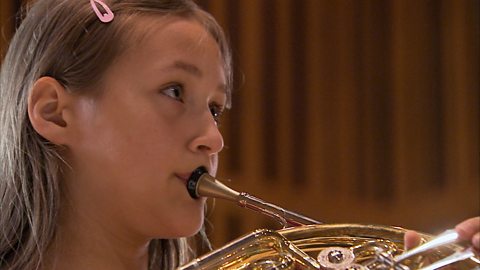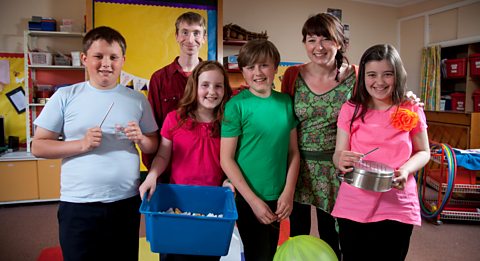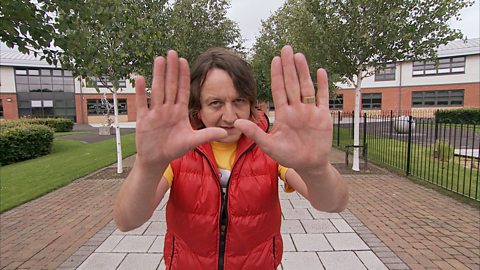We've got a really nice outcome.
It's just amazing.
This is what we know todayas a silent movie.
But back in 1914, when audiencesfirst watched Charlie Chaplinstarring as the Tramp, they didn'twatch it in silence.That's becausemusicians were employed in eachand every cinema to play live music.Their job was to watch the filmand make up music thatcomplemented the action.
Mike Nolan keepsthis tradition alive.He's been improvising music forold silent movies for 20 years.I'm here to pick his brains.
What top tips would you have forsomeone who wants to compose musicfor action for the first time?
OK.The first thingI would want to do is reallyget into the mood of the filmand the mood of the character.Are they in a really blind panic?
PLAYS FRANTICALLY
I would think about, where are they?Are they on a boat?
PLAYS CALMLY
I would also think aboutthe speed of the action.Are they running away from a train?
TENSE MUSIC
Great tips. Thanks very much.
So we've seen how musicused to be played in cinemasto accompany a film,but that was back then.This is now.
I've made a filmbut it's not finished yet.Like the old Charlie Chaplin movie,it needs music to bring it to life.I'm about to meet up with composerLauren Hayes, who I think can help.She specialises in usingelectronic sounds,which will be greatfor my futuristic setting.
Today, Lauren is working withSam, Catherine, Liana and Essen.They'll be using a games controller,a keyboard, a crackle box,and a microphone to make digitalsounds, using Lauren's computer.
Time to hand this jobover to our composers.
Before they startworking on my film,they'll need to take a closerlook at it to help them imaginewhat sounds will be bestto tell the story.
Let's think about the movementfirst.What's the robot doing just now?
ALL: Walking.
Yeah, so he's walking towardsthe girl. We could do robot noises.And then in the middle of the film,they had a kind of struggle.
A tug-of-war.
Exactly.
Now we're going to havea look at it againand think about the kindof emotions the charactersare feeling in the film,so if they're happy, sad, angry.
Let's have a look and see. Right now,what does she look like? Happy.
She looks really happy. And nowshe looks… Surprised. Exactly.Why do you think that is?The robot is coming towards her.And what you think the girl isthinking. Maybe fancies her?
Like kind of, "Oh, he loves me."
Exactly.Now, what's happening?
They're fighting.
What kind of emotion is that?
Crying.
Yeah, the girl looks really sad.
The robot's got his flower, so he'sfeeling…? Over the moon. Excellent.
So they've sorted out and agreedthe emotions and actions of my film.Now all they have to dois start composing.
PEACEFUL HAPPY MUSIC
This sounds like it could bethe happy music for the beginning.
MECHANICAL ROBOT SOUNDS
He's got it. He's watching the filmand bringing the action to life.It's really workingwith the picture.
I want that flower.
HIGH PITCHED: Oh, I think he fancies me.
These are great sounds.
She's imagining what my characterswould be thinking and saying.
ELECTRONIC CRACKLES
The movement of the robot,brilliant.
I wondered what that boxwould sound like.
Great, so now we're goingto all try it together.This should be interesting.This will be the first timeour musicians have played together.
Let's go, and…action.
PEACEFUL HAPPY MUSIC
ROBOTIC SOUNDS
ELECTRONIC SQUEAKING
HIGH-PITCHED SQUEAKING
This is lookingand sounding really interesting now.
Guys, is my film ready, completewith soundtrack?
ALL: Yes.
OK, roll the film.
PEACEFUL HAPPY SOUNDS.
ELECTRONIC SQUEAKING
ROBOTIC SOUNDS
HIGH-PITCHED SQUEAKING
ROBOTIC SOUNDS
TENSE RUMBLING
HIGH-PITCHED SQUEAKING
CONTENTED ROBOT SOUNDS
Fantastic, guys. Well done.
Thank you.
Video summary
A group of children help composer Lauren Hayes make a soundtrack for Kid Carpet’s silent film.
They first study how music manipulates emotions and conveys mood in films.
The group then use electronic sounds to match the movement and mood of the characters on screen, recording and manipulating the sounds effects on a computer, to produce their very own soundtrack.
This is from the series: Compose Yourself
Teacher Notes
Students could be provided with, or make their own, short silent film.
They could use a mobile phone or camcorder to shoot the film, before uploading it onto a computer for editing. Ideally, it would be a simple clip with obvious contrasts in mood, character and action.
Encourage pupils to select sounds to accompany the film and think about how they should be arranged.
They should pay careful attention to all aspects of the plot, characters and emotions.
In the clip, the group plays 'live' to accompany the film.
There are advantages to this, most obviously in terms of synchronisation of sound and image, but by using computer software, the sounds can be recorded in time with the film.
This clip will be relevant for teaching Music at KS3 in England, Wales and Northern Ireland. Also 2nd and 3rd level in Scotland.
Finding sounds around you to create music. video
Kid Carpet joins composer Jules Rawlinson and a class of schoolchildren to experiment with ‘found sounds’.

Taking inspiration from your surroundings to compose music. video
A group of children from Gateshead try to produce a piece of music inspired by the Tyne Bridge.

Using everyday objects to create music. video
A group of children work with musical group ‘Trash’ to compose a piece of music using only rubbish and recycled objects.

Composing a piece of music using unpitched percussion. video
A group of children, who have no experience of composing music, work as a team to produce a short piece performed entirely using their voices and clapping.
